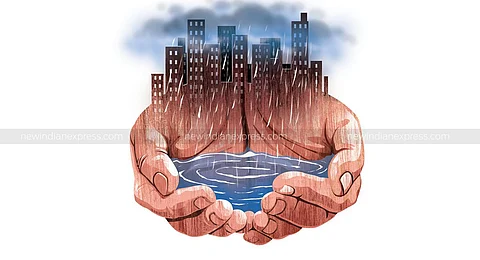

NEW DELHI: Two different surveys in recent times show India’s groundwater is depleting further though the administration appears to have selectively interpreted data to indicate otherwise. On December 1, the Union Ministry of Water Resources released the Dynamic Ground Water Resource Assessment Report 2023, which claimed the groundwater recharge is increasing and the number of over-exploited units of groundwater sources are decreasing. However, it underplayed the fact that the extraction of groundwater has increased. Moreover, the sample size of the countrywide assessment points of groundwater had inexplicably come down.
The total annual groundwater extraction in 2023 was estimated at 241.34 billion cubic metres (BCM), with the agriculture sector being its largest consumer accounting for 87% (209.74 BCM), followed by domestic 11% (27.57 BCM) and industrial 2% (4.01 BCM). The report showed that the total annual groundwater recharge for the entire country is 449.08 BCM, marking an increase of 11.48 BCM compared to 2022. The increased recharge was in West Bengal, Assam, Telangana, Chhattisgarh, Karnataka, Gujarat and Bihar.

“But it does not clarify as to where the recharge is increasing and where there is improvement in the groundwater situation,” observes Himanshu Thakkar of South Asia Network of Dam Rivers and People. “The increase in recharge would be useless if it is happening in waterlogged or salinized areas or where groundwater quality is bad,” he adds. For example, groundwater in parts of West Bengal, Bihar, Assam, and Chhattisgarh are high in arsenic contamination. The report claims higher groundwater recharge in these states. But if it is happening in contaminated areas, it would serve no purpose.
The 6th Minor Irrigation Census also casts a shadow on the claim of the groundwater report. The Census report, which was released in August 2023, showed an increase in deep tubewells and a decreasing trend in traditional dugwells and shallow tubewells. Deep tubewells (up to 300 metres) went up by 43% while medium tubewells (35-70 metres) registered a jump of 36% to extract groundwater for irrigation. Strangely, the sample size of the assessment points in the groundwater assessment report has come down. From 5,723 in 2004, the sample size increased to 7,089 in 2022 but dropped to 6,553 in 2023.
State of groundwater
This was the 10th groundwater assessment exercise jointly done by the Central Ground Water Board and states and Union Territories. The earlier nine assessments were done in 1980, 1995, 2004, 2009, 2011, 2013, 2017, 2020 and 2022.
The report shows that there are 736 (11.23%) units that have been categorised as over-exploited, indicating groundwater extraction exceeding the annually replenishable recharge rate. As many as 17% of the rechargeworthy areas of the country’s total 24.67 lakh sq km are under the over-exploited category. Besides, 199 (3.04 %) assessment units are categorised as critical, where groundwater extraction is between 90-100%.
There are 698 (10.65 %) semi-critical units, where the stage of groundwater extraction is between 70% and 90%. On the flip side, 4,793 (73.14 %) units are categorised as safe, where extraction is less than 70%. Around 2% of the assessment units are on the saline list.